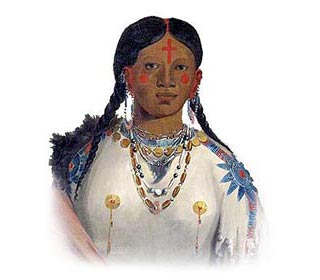They were first used as gifts of friendship and then for trade. Native Americans soon became particularly adept at beadwork and glass beads were used to adorn many different articles of clothing and used to decorate sashes, garters, belts, knife sheaf, cradles and many types of bags and pouches. Glass Beads Fact Sheet - Glass Beads Fact 1: Before glass beads became readily available as trade items Native Americans made their jewelry and adornments from the natural resources that were available to them such as stones, animal bones, seeds, shells, and porcupine quills
- Glass Beads Fact 2: Great use was made of the ornaments and Native Indians became highly skilled at beadwork, which they used to decorate every type of clothing from tunics, dresses, skirts, blouses and capes. Even belts and garters had beadwork, as did every type of pouch and bag that was used
- Glass Beads Fact 3: Early records show that the Mohawk tribe had glass beads by 1616
- Glass Beads Fact 4: This type of decoration originated in Venice, Italy, the glass making center of Europe.
- Glass Beads Fact 5: They were transported across North America to traders by pony-pack trains and were given the nickname of "pony beads". They were also referred to as 'Hudson's Bay Beads' as the biggest trading company.
- Glass Beads Fact 6: They were highly prized at first but as they became increasingly common their value decreased
- Glass Beads Fact 7: They became a highly desirable commodity because they replaced the shell and stone beads that required extensive amounts of time to produce
- Glass Beads Fact 8: They came in many different sizes, colors and shapes. Various beading techniques were developed by individual tribes and patterns and designs contained many motifs and symbols that could be attributed to each tribe
- Glass Beads Fact 9: The colors included different shades and hues of red, white, green, yellow, black and blue
- Glass Beads Fact 10: The tribes of the Great Plains and the Southwest created beadwork that featured geometric motifs
- Glass Beads Fact 11: The Woodland and Northwest Coast tribes created floral designs on their beadwork
- Glass Beads Fact 12: Beadwork was first used to decorate Deerskin clothing but as trade increased it was used to decorate clothes made with Trade Cloth
- Glass Beads Fact 13: The techniques applied to beadwork included weaving or "loom beading", stringing, knotting and netting
- Glass Beads Fact 14: The stitching methods included overlay and 'lazy stitching'
- Glass Beads Fact 15: The Crees, Nez Perce and the Blackfoot tribe favored striped designs. The dresses of the women featured long horizontal beadwork over the bodice and the sleeves
- Glass Beads Fact 16: Beadwork designs used by the Mandan, Arikara and Crows often featured the color yellow
- Beadwork Fact 17: The beadwork of the Sioux, Utes and Cheyenne often featured circles and triangular shapes
- Beadwork Fact 18: As time went by beadwork designs, motifs and patterns changed. Realist designs were adopted featuring horses, bison, human hands and people
|
